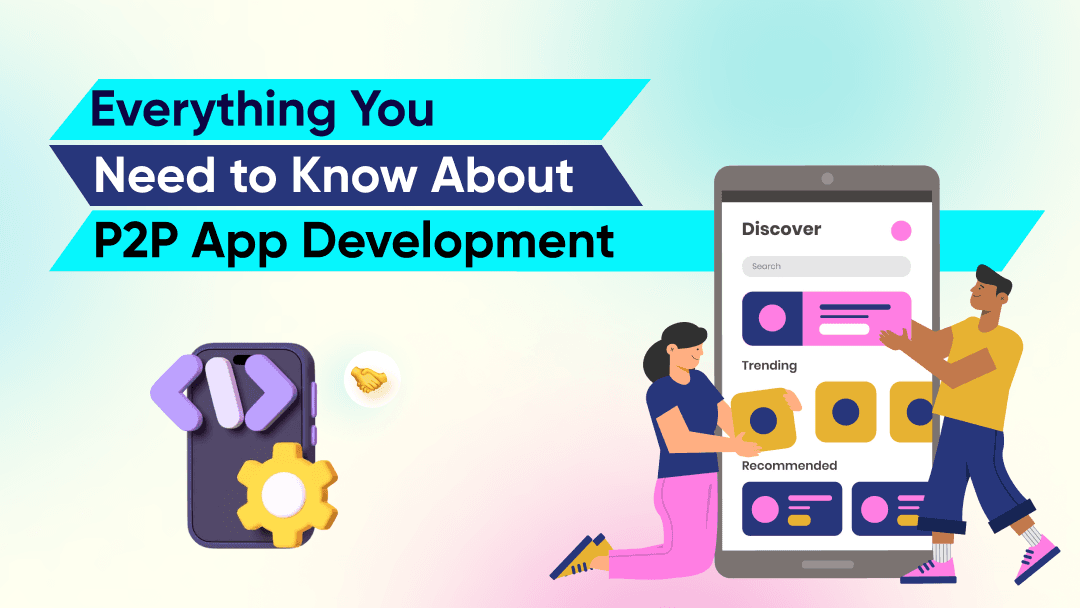Everything You Need to Know About P2P App Development

Quick Summary: Peer-to-peer (P2P) applications have tremendously changed the way people transact online. Back then, it was a struggle to get a personal loan from a bank, involving a series of formalities, making the process hectic and time-consuming. But now, it is not. During the COVID pandemic, the demand for loan apps increased, as millions of people lost their jobs. Faced with financial pitfalls, many quickly needed to borrow money, leading to the growing demand for P2P app development, and now it has become easier than ever for people to get loans with low interest rates. From financial money lending services to exchanging words, P2P apps enable direct interactions and transactions between users without the need for intermediaries.
Examples of P2P applications that are running successfully worldwide-
- File sharing- BitTorrent
- Communication– WhatsApp and Skype
- Financial services– PayPal, Venmo, and Zelle allow users to send and receive money directly.
Research predicts that the valuation of the P2P market will reach $ 150 billion by the year 2025. (Source)
What is a P2P lending app?
A peer-to-peer lending app offers convenient money lending where the borrowers and the money lenders are equal parties, involving the individuals and the companies. The interest rate is low, as there are no intermediaries involved in the money lending process.
The best part of P2P lending apps is that you do not need to go through any maintenance expenses like renting premises, staff fees, software, laptops etc. You may simply have to hire a peer to peer lending app development company to get an interactive and functional app built.
Steps to build a P2P app
- Conduct a market research-
Ask questions or conduct a survey with your target market to know the demand for P2P apps in the domain your business operates. This will give you insights into user preferences and pain points to assist the development process. If you plan to monetize your app, familiarize yourself with all the legal and regulatory formalities of p2p lending apps so as to avoid any inconveniences in future.
- Create a plan-
Draft a detailed plan on the overall architecture of the app, and select a stack of technologies that you would like to employ while working on the app. Choose the languages and frameworks like java, node.js, react etc that are to be used in the project.
- Craft the p2p app’s UX/UI-
Design the overall look of your app. How the chat window would look, or how the user will navigate throughout the app. Ensure the navigation is smooth enough to satisfy the user. You may develop a prototype of your app to share it with experts and gather their feedback.
- Develop the app-
Set up a healthy development environment with the necessary resources to assist a team of developers, project managers and quality engineers.
- Implement security measures-
Implement effective and reliable security measures like encryption and authentication to protect the user data while transactions.
- Launch and monitor-
After ensuring every aspect of your app is running successfully, make it live on the platform and keep a track on its performance and user feedback. Update the app by fixing the bugs, or improving its features.
Trends in peer to peer payment applications
- Payment apps integrated directly into chats or social media apps. (Like whatsapp pay)
- Voice commands to transfer money (Alexa, Siri, or Google Assistant)
- Rewards and bonus points
- Branded and premium credit cards
- Contactless payment options (Bluetooth, NFC)
- Crypto trading
- Crypto payment apps
- Currency exchange payment apps (Payoneer, Paypal)
- Scanners to pay sellers
- Buy now pay later
- Use of AI to reduce frauds and misuse of the application
- NFC stickers for contactless payments
- Social e-commerce
- Integrated with wearables
- Biometric authentication for security
Statistics to justify the love for P2P apps
- The p2p payment industry was valued at a hefty $4.83 billion in 2023, and it is expected to stay around $3.07 billion by 2028. This shift indicates a mature and a stable market for p2p payment apps ahead in time.
- In the US, about 62% of smartphone users are using p2p apps for smooth and seamless transactions, which is expected to rise by 2026.
- Frauds are also increasing, with total losses of around $1.7 billion in 2022, which is a 90% increase from 2021.
- 8% of banking customers report falling victim to a p2p scam.
Challenges in p2p app development
- Development hurdles
An effective launch should be followed by greater visibility and rapid downloads. Without flexibility to make changes, your app may face development obstacles like service interruptions, unpredictable shutdowns, and a rapid turnover rate.
- Privacy
Customers trust p2p payment apps to safeguard their confidential data. It could damage your brand’s identity if attackers access the private information of users and misuse that information.
- Statutory adherence
Every feature and technologies used while developing the application must adhere to the laws in order to function legally. For example, some payment applications that gather credit card information from users should follow the PCI DSS.
- Technical failures
It requires a dedicated team of exceptionally competent IT professionals to develop a p2p application. Several components such as a digital wallet, encoding, APIs, and blockchain technology are interconnected and utilized while developing an app.
- Flexibility
The user behavior and preferences are constantly shifting and undergoing a change. Supporting basic payment transactions is the key, but comprehending user behavior and adjusting an app is also important to survive in the competitive marketplace. For example, all the payment apps need to be integrated with taxi services otherwise they would become irrelevant soon.
Conclusion
The world is quickly adapting to the trend of hassle free payments and personal loans. P2p apps are becoming increasingly popular with both banks and consumers. Thus, now is the right opportunity to develop a p2p app and position yourself as a strong player in the market.
Do you have any thoughts about developing unique mobile applications? Contact us right away!

Have an idea?
Get in touch, we’d be
happy to hear from you
We are always looking out for new collaborations, whether you are a client who is passionate about a project or a talent who is interested in joining our team, our doors are always open.
locate us

India (HQ)
618, Shekhar Central, Palasia Square, A.B Road, Indore, Madhya Pradesh, 452001
+918109561401

United Kingdom
Brain Inventory, SBVS, 8 Roundhay Road, Leeds, UK, LS7 1AB
+18008209286

Canada
44 Main Street East Milton, ONCanada L9T 1N3
+4166696505

Jordan
185 Wasfi Al-Tal Street, Ammon Oasis Complex P.O Box 4724 Amman 11953 Jordan
+960770781000

USA
720 Seneca St Ste 107 Seattle, USA 98101
+1(206)6533419
if it's digital,we'll make it.
- Numetric - Online Accounting Software similar to QuickBooks
- Bloomia - Kegel exercise
- Virifi - Blockchain Powered Document Certification & Signing Platform
- Revolution Travel CRM - Custom CRM Built for Travel Agents
- Fatoura - Online Invoicing Platform
- My Fit Mantra - Your health partner
- Ocureel - Relation Building and video sharing Application